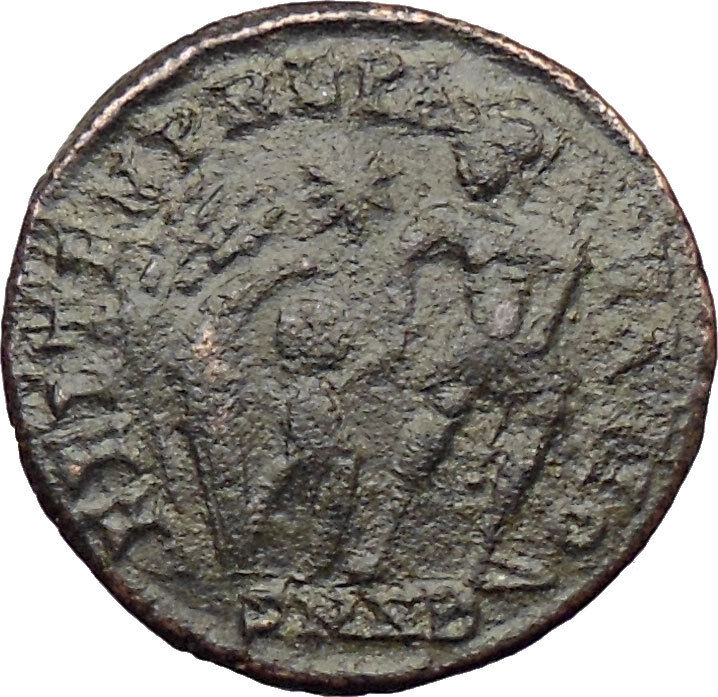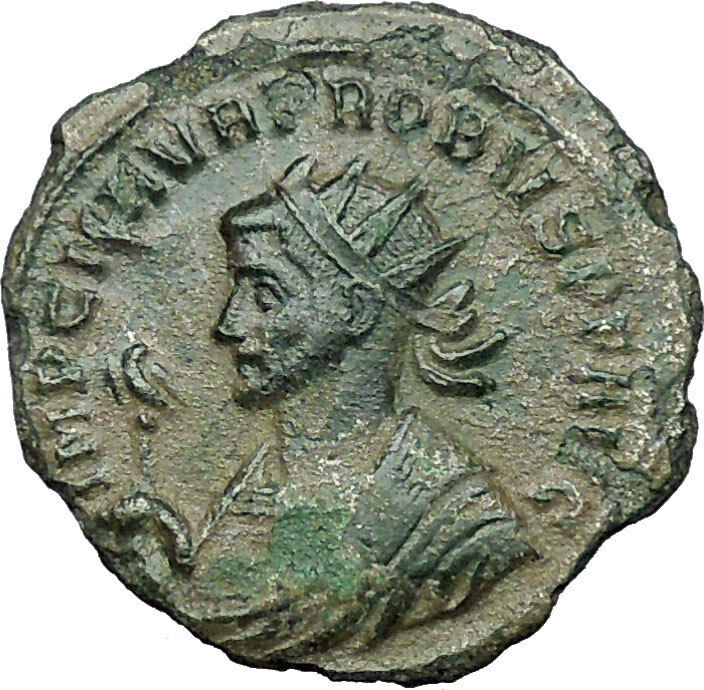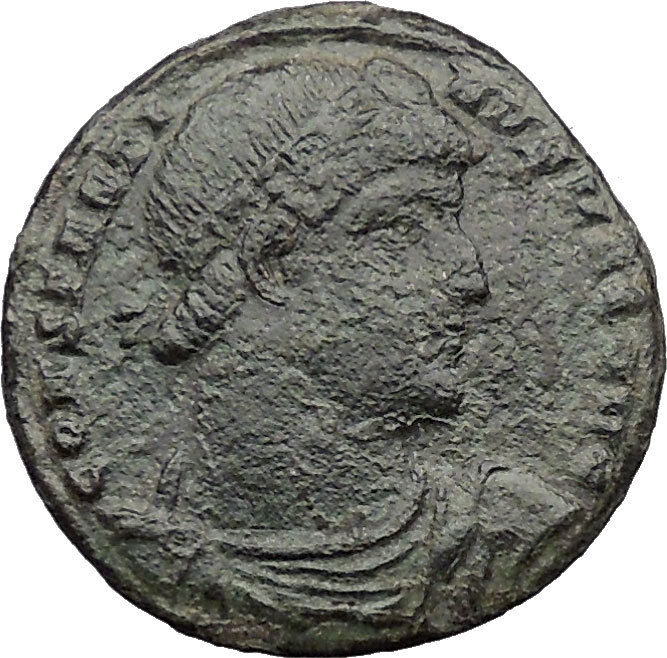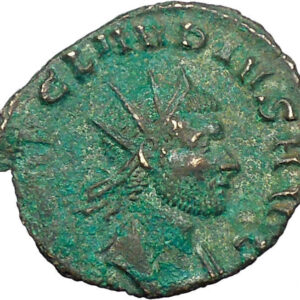|
Faustina I – Roman Empress Wife of Roman Emperor Antoninus
Pius –
Posthumous Issue
Bronze As 25mm (8.90 grams) Rome mint: 148-161 A.D.
Reference: RIC 1178 (Antoninus Pius), S 4648, C 114
DIVAFAVSTINA – Draped bust right.
AVGVSTA – Vesta standing left, holding Palladium and torch
The torch is a common
emblem
of both
enlightenment
and
hope. Thus the
Statue of Liberty
, actually “Liberty
Enlightening the World”, lifts her torch. Crossed reversed torches were signs of
mourning that appear on Greek and Roman funerary monuments—a torch pointed
downwards symbolizes death
, while a torch held up symbolizes life,
truth and the regenerative power of flame.
You are bidding on the exact item pictured,
provided with a Certificate of Authenticity and Lifetime Guarantee of
Authenticity.
Vesta
was the
virgin
goddess of the
hearth
, home, and family in
Roman religion
. Vesta’s presence was symbolized
by the
sacred fire
that burned at her hearth and
temples.
Vesta’s (in some versions she is called Vestia) fire was guarded at her
Temples by her priestesses
, the
Vestales
. Every March 1 the fire was renewed.
It burned until 391
, when the Emperor
Theodosius I
forbade public
pagan
worship. One of the Vestales mentioned in
mythology was
Rhea Silvia
, who with the God
Mars
conceived
Romulus and Remus
(see
founding of Rome
).
The Vestales were one of the few full-time
clergy
positions in
Roman religion
. They were drawn from the
patrician
class and had to observe absolute
chastity
for 30 years. It was from this that
the Vestales were named the Vestal virgins. They could not show excessive care
of their person, and they were not allowed to let the fire go out. The Vestal
Virgins lived together in a house near the Forum (Atrium Vestae),
supervised by the
Pontifex Maximus
. On becoming a priestess, a
Vestal Virgin was legally emancipated from her father’s authority and swore a
vow of chastity for 30 years. This vow was so sacred that if it were broken, the
Vestal was buried alive in the Campus Sceleris (‘Field of Wickedness’).
It is likely that this is what happened to
Rhea Silvia
. They were also very independent
and had many privileges that normal women did not have. They could move around
the city but had to be in a carriage.
The Vestales had a strict relationship with the
rex sacrorum
and
flamen dialis
as is shown in the verses of Ovid
about their taking the februae (lanas: woolen threads) from the
king and the flamen. Their relationship with the king is also apparent in the
ritual phrase: “Vigilasne rex, vigila!” by which they apostrophated him. The
sacrality of their functions is well compounded by Cicero’s opinion that without
them Rome could not exist as it would not be able to keep contact with gods.
A peculiar duty of the vestals was the preparation and conservation of the
sacred salamoia
muries
used for the savouring of the mola
or mola salsa
, dough to be spread on sacrificial
victims, a procedure known as
immolation
. This dough too was prepared by them
on fixed days. Theirs also the task of preparing the
suffimen
for the
Parilia
.

Temple of Vesta in Italy
In
Greek
and
Roman mythology
, a
palladium
or palladion was an
image
of great antiquity on which the safety of
a city was said to depend. “Palladium” especially signified the wooden statue (xoanon)
of Pallas Athena
that
Odysseus
and
Diomedes
stole from the
citadel
of
Troy and which was later taken to the future site of
Rome by Aeneas
. The Roman story is related in
Virgil
‘s
Aeneid
and other works. In
English
, since circa 1600, the word
“palladium” has meant anything believed to provide protection or safety — a
safeguard.

Origins
The Trojan Palladium was said to be a wooden image of
Pallas
(whom the
Greeks
identified with
Athena
and the
Romans
with Minerva) and to have fallen from
heaven in answer to the prayer of
Ilus, the founder of
Troy.
“The most ancient talismanic
effigies
of Athena,”
Ruck
and
Staples
report, “…were magical found objects,
faceless pillars of Earth in the old manner, before the Goddess was
anthropomorphized
and given form through the
intervention of human intellectual meddling.”
Arrival
at Troy
The arrival at Troy of the Palladium, fashioned by Athena in remorse for the
death of Pallas, as part of the city’s
founding myth
, was variously referred to by
Greeks, from the seventh century BC onwards. The Palladium was linked to the
Samothrace mysteries
through the pre-Olympian
figure of an Elektra, mother of Dardanus, progenitor of the Trojan royal line,
and of Iasion
, founder of the Samothrace mysteries.
Whether Electra had come to Athena’s shrine of the Palladium as a pregnant
suppliant and a god cast it into the territory of Ilium, because it had been
profaned by the hands of a woman who was not a virgin, or whether Elektra
carried it herself or whether it was given directly to Dardanus vary in sources
and
scholia
. In Ilion, King
Ilus was blinded for touching the image to preserve it from a burning
temple.
Theft
During the
Trojan War
, the importance of the Palladium to
Troy was said to have been revealed to the Greeks by
Helenus
, the prophetic son of
Priam
. After Paris’ death, Helenus left the
city but was captured by Odysseus. The Greeks somehow managed to persuade the
warrior seer to reveal the weakness of Troy. The Greeks learned from Helenus,
that Troy would not fall while the Palladium, image or statue of Athena,
remained within Troy’s walls. The difficult task of stealing this sacred statue
again fell upon the shoulders of Odysseus and Diomedes. Since Troy could not be
captured while it safeguarded this image, the Greeks
Diomedes
and
Odysseus
made their way to the
citadel
in Troy by a
secret passage
and carried it off. In this way
the Greeks were then able to enter Troy and lay it waste using the deceit of the
Trojan Horse
.
Odysseus, some say, went by night to Troy, and leaving Diomedes waiting,
disguised himself and entered the city as a beggar. There he was recognized by
Helen
, who told him where the Palladium was.
Diomedes then climbed the wall of Troy and entered the city. Together, the two
friends killed several guards and one or more priests of Athena’s temple and
stole the Palladium “with their bloodstained hands”. Diomedes is generally
regarded as the person who physically removed the Palladium and carried it away
to the ships. There are several statues and many ancient drawings of him with
the Palladium.
According to the
Epic Cycle
narrative of the
Little Iliad
, on the way to the ships,
Odysseus plotted to kill Diomedes and claim the Palladium (or perhaps the credit
for gaining it) for himself. He raised his sword to stab Diomedes in the back.
Diomedes was alerted to the danger by glimpsing the gleam of the sword in the
moonlight. He disarmed Odysseus, tied his hands, and drove him along in front,
beating his back with the flat of his sword. From this action was said to have
arisen the Greek proverbial expression “Diomedes’ necessity”, applied to those
who act under compulsion. Because Odysseus was essential for the destruction of
Troy, Diomedes refrained from punishing him.
Diomedes took the Palladium with him when he left Troy. According to some
stories, he brought it to Italy. Some say that it was stolen from him on the
way.
Arrival
at Rome
According to various versions of this legend the Trojan Palladium found its
way to Athens
, or
Argos
, or
Sparta
(all in
Greece
), or
Rome in Italy
. To this last city it was either brought
by Aeneas the exiled Trojan (Diomedes, in this version, having only succeeded in
stealing an imitation of the statue) or surrendered by Diomedes himself. It was
kept there in the
Temple of Vesta
in the
Roman Forum
.
Pliny the Elder
said that
Lucius Caecilius Metellus
had been blinded by
fire when he rescued the Palladium from the
Temple of Vesta
in 241 BC, an episode alluded
to in Ovid
and
Valerius Maximus
When the controversial emperor
Elagabalus
(reigned 218-222) transferred the
most sacred relics of Roman religion from their respective shrines to the
Elagabalium
, the Palladium was among them.
In
Late Antiquity
, it was rumored that the
Palladium was transferred from Rome to
Constantinople
by
Constantine the Great
and buried under the
Column of Constantine
in his forum. Such a move
would have undermined the primacy of Rome, and was naturally seen as a move by
Constantine to legitimize his reign.
 Annia Annia
Galeria Faustina, more familiarly referred to as Faustina the Elder (Latin:
Faustina Major; born
September 21
about 100, died October or November 140), was a Roman Empress and wife of
Roman
Emperor
Antoninus Pius
.
Faustina was the only known daughter of consul and prefect
Marcus Annius Verus
and
Rupilia
Faustina. Her brothers were consul
Marcus Annius Libo
and
praetor
Marcus Annius Verus
. Her maternal aunts perhaps were Roman Empress
Vibia
Sabina
,
Matidia Minor
. Her paternal grandfather had the same name as her father and
her maternal grandparents possibly were
Salonina Matidia
(niece of Roman Emperor
Trajan
) and
suffect consul
Lucius Scribonius Libo Rupilius Frugi Bonus
. Faustina was born and raised in
Rome.
As a private citizen, she married Antoninus Pius between 110
and 115. Faustina and Antoninus had a very happy marriage. Faustina bore
Antoninus four children, two sons and two daughters. They were:
-
Marcus Aurelius Fulvius Antoninus (died before 138); his
sepulchral inscription has been found at the Mausoleum of Hadrian in Rome.
-
Marcus Galerius Aurelius Antoninus (died before 138); his
sepulchral inscription has been found at the Mausoleum of Hadrian in Rome.
His name appears on a Greek Imperial coin.
-
Aurelia Fadilla (died in 135); she married Aelius Lamia
Silvanus or Syllanus. She appears to have had no children with her husband
and her sepulchral inscription has been found in
Italy
.
-
Annia Galeria Faustina Minor or
Faustina the Younger
(between 125-130-175), a future Roman Empress; she
married her maternal cousin, future Roman Emperor
Marcus Aurelius
. She was the only child who survived to adulthood.
On
July 10
,
138, her uncle
emperor Hadrian
had died and her husband became the new emperor. Antoninus was Hadrian’s adopted
son and heir. Faustina became Roman Empress and the senate accorded her the
title of
Augusta
. Faustina as an empress was well respected and this beautiful
woman was renowned for her wisdom. The
Augustan History
impugned her character, criticizing her as having
“excessive frankness” and “levity”. However, this doesn’t appear to be the case
with her character. Throughout her life, Faustina as a private citizen and an
empress was involved in assisting with charities, assisting the poor and
sponsoring and assisting in the education of Roman children, particularly of
Roman girls.
She can be viewed as one of the most moral, stable and
respected empresses in the history of the
Roman
Empire
. When Faustina died, Antoninus was in complete mourning for Faustina.
Antoninus did the following in memory of his loving wife:
-
Deified her
as a goddess (her apotheosis was portrayed on an
honorary column
)
-
Had
a temple
built in the
Roman
Forum
in her name, with priestesses in the temple.
-
Had various coins with her portrait struck in her honor.
These coins were inscribed DIVA FAVSTINA (“Divine Faustina”)
and were elaborately decorated.
-
Founded a charity called Puellae Faustinianae or
Girls of Faustina, which assisted orphaned girls.
-
Created a new alimenta (see
Grain supply to the city of Rome
).
In 2008, archaeologists digging at the ancient site of
Sagalassos
in Turkey
discovered a colossal marble head which is believed to be that of Faustina.
|








 Annia
Annia 


